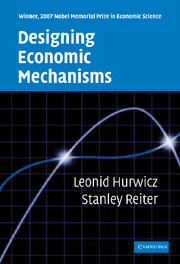1 - Mechanisms and Mechanism Design
Published online by Cambridge University Press: 24 May 2010
Summary
Introduction
Our aim in this book is to present systematic methods for designing decentralized economic mechanisms whose performance attains specified goals. We begin with an informal discussion of the general problem, and of our approach to it. A (decentralized) mechanism is a formal entity intended to represent a system for organizing and coordinating economic activity. The need for such mechanisms can arise at different levels of economic entities, ranging from households, or firms, to government agencies, to entire economies. We discuss examples at several levels.
Economic activity has been classified as production, consumption, and exchange. These activities are constrained by restrictions on resource availabilities, and on knowledge of technological possibilities. Resource availabilities and technological possibilities form part of the economic environment, that is, at any one time they are exogenously given, either from nature, or inherited from the past. Knowledge of resource constraints and of technological possibilities is generally distributed among economic agents. Consequently no economic agent, or other entity, can know the totality of what is feasible and what is not. The preferences of economic agents are also distributed among agents; they are typically interpreted as private information and are usually taken as exogenously given. They play a dual role: they underlie the motivations of agents, and in that role form part of the economic environment, and they also play a role in determining the criteria of economic efficiency and hence in defining the goals of economic activity.
- Type
- Chapter
- Information
- Designing Economic Mechanisms , pp. 14 - 62Publisher: Cambridge University PressPrint publication year: 2006



